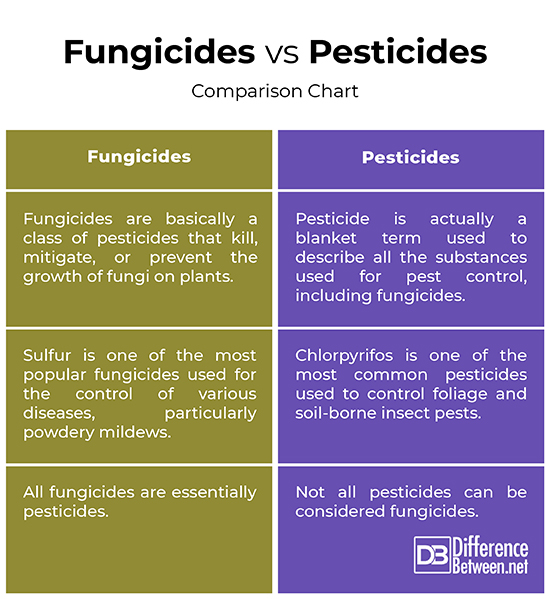Difference Between Fungicides and Pesticides
Pesticides are the farmers’ most essential tool that ensures quality and quantity of crops to satisfy an increasing human population. Pesticides are often viewed as an efficient, labor-saving tool to control harmful pests and insects from damaging the crops and eventually prevent crop yield losses. Use of pesticides has been known and practiced since the prehistoric times. A little has changed since then. The availability of a wider range of chemicals and global marketing of pesticides has led to a global growth in their usage. Well known pesticides include insecticides, herbicides, and fungicides.

Pesticide
Pesticides are chemical substances used to control, prevent, or mitigate the growth of pests or weeds in crops. They protect crops from diseases and infestation, and considered important for protecting harvests and ensuring consistent food supply. Pesticide is a general term used to describe a mixture or substance that ensures maximum crop yield by killing pests, insects, rodents, fungi, and weeds that threaten the growth of plants. It was the development of synthetic organic pesticides following the World War II that revolutionized the control of pests.
Pesticide is actually a blanket term used to describe all the substances used for pest control, such as insecticides, herbicides, and fungicides. Some lesser known pesticides are disinfectants, plant defoliants, etc. All pesticides contain active substances which are the essential ingredients that ensure they function properly. This can be a chemical or a microorganism, such as a bacterium or a virus. In some cases, the chemical confuses the insects, or in some cases, makes the crop less palatable for insects or pests. But most commonly, pesticides work by killing the insects, weeds, or fungi.

Fungicide
Fungicide, as the name suggests, is a type of pesticide that controls fungal infections by killing the fungus. Fungi are one of the major causes of crop loss worldwide. Fungicides are biocidal chemical compounds or biological organisms used to eradicate or prevent the growth of fungi or their spores. They are predominantly used to mitigate foliar diseases on a wide range of veggies, field, fruits, and ornamental crops, but they are not effective against bacteria, nematodes, or viral diseases.
Sulfur is one of the most preferred fungicides used for the control of various diseases, particularly powdery mildews. The use of sulfur to protect vines dates back to ancient Greek civilizations and with Bordeaux mixture since the end of the 19th century. Most of the recent developments of fungicides have occurred in the past few decades. Though sulfur is used in its natural state, some other specific forms of sulfur produced by chemical reactions are also used.
Difference between Fungicides and Pesticides
Type
– Pesticide is actually a blanket term used to describe all the substances used for pest control, such as insecticides, herbicides, and fungicides. Pesticides are chemical substances used to control, prevent, or mitigate the growth of pests or weeds in crops. Fungicide is essentially a class of pesticides that controls fungal infections by killing the fungi. So, fungicides are basically pesticides that kill, mitigate, or prevent the growth of fungi on plants, but they are not very effective against bacteria.
Active Ingredients
– Active ingredients are the chemical substances in pesticides that destroy or repel the pests, and make up a small portion of the whole product. Chlorpyrifos is one of the most widely pesticides on crops, and also used in non-agricultural settings. It is an organophosphate pesticide primarily used to control foliage and soil-borne insect pests. Fungicides are typically divided into two groups – one controls the diseases of growing plants and the other one is seed disinfectants. Sulfur is one of the most popular fungicides used for the control of various diseases, particularly powdery mildews.
Fungicides vs. Pesticides: Comparison Chart

Summary
So in a nutshell, Pesticide is actually a blanket term used to describe all the substances used for pest control, including fungicides whereas fungicides are a type of pesticides used to kill, mitigate, or prevent the growth of fungi on plants. This basically means all fungicides are essentially pesticides but not all pesticides are fungicides. Both ensure maximum crop yield by killing pests, insects, rodents, fungi, and weeds that threaten the growth of plants. However, the effectiveness of any control measure with chemical compounds depends largely on the chemical that comes into contact with the pest that needs to be destroyed, which in turn depends on how the formulation is prepared.
What is the difference between a pesticide and an insecticide?
Pesticides are chemical substances used to control, prevent, or mitigate the growth of pests or weeds in crops. It is catchall term used to describe all the substances used to kill pests, insects, rodents, fungi, and weeds. Insecticides are a form of pesticides used to kill one or more species of insects.
What is the difference between a pesticide and a herbicide?
Pesticide is blanket term used to describe all the substances used to kill pests, insects, rodents, fungi, and weeds, and that also include herbicides, which are chemical substances that are toxic to plants, used to destroy undesired plants on farms.
What is an example of a fungicide?
Sulfur is one of the most preferred fungicides used for the control of various diseases, particularly powdery mildews. And the most popular compound in the sulfur groups is dithiocarbamates, a synthetic organic compound used to control multiple fungal diseases.
- Difference Between Caucus and Primary - June 18, 2024
- Difference Between PPO and POS - May 30, 2024
- Difference Between RFID and NFC - May 28, 2024
Search DifferenceBetween.net :
Leave a Response
References :
[0]Ramulu, Sree. Chemistry of Insecticides and Fungicides (3rd Edition). Jodhpur, India: Scientific Publishers, 2020. Print
[1]Matthews, Graham. Pesticides: Health, Safety and the Environment. New Jersey, United States: John Wiley & Sons, 2008. Print
[2]Marrs, Timothy T. and Bryan Ballantyne. Pesticide Toxicology and International Regulation. New Jersey, United States: John Wiley & Sons, 2004. Print
